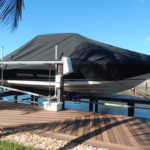In this article, I want to discuss one of the most important parts of the boat, the propeller. Specifically, I want to answer a question I often see online and have been asked recently.
That question is: Can you run a boat with a bent prop? Yes, you can run a boat with a bent prop, but I don’t recommend it. A bent prop is not as efficient. It will slow down your speed and cost more fuel (like a flat tire on a car). It can also damage the rest of your boat or stop working in the open water, which can leave you stranded.
Read on to learn more about running a boat with a bent prop and why it isn’t a good idea.
Also, for an excellent propeller, take a look at our top pick, the Turning Point Propeller 31431730:
Click here to see it on Amazon.
Can You Run a Boat with a Bent Prop?
A motorboat would be nothing without its propeller. A propeller doesn’t just help give you propulsion—it is one of the most important parts of the boat.
The propeller is so important because it is the hardest working part of the entire boat. This means there are more chances of your propeller being bent over time. This can be a serious issue if left unchecked.
With all that said, the propeller’s build quality is a major concern when it comes to identifying structural issues and even predicting them. Considering that modern boats come with high horsepower levels, the propeller’s build material needs to be top-quality to stay rigid and not bend over time.
Some flexibility is important here, as it has to cut the air to create propulsion. But it needs to be made of sturdy material to go through the number of rotations it goes through with such a massive torque behind it.
A Bent Prop — and What It Means for Your Boat
The torque a propeller takes on is directly proportional to the boat’s speed and the overall price of the boat. However, on the other side, the torque is also directly proportional to how much time it will take to get damaged.
To put it simply, there are two common types of damages that can happen to the propeller:
- The wings of the propeller bend in a direction they shouldn’t be bending.
- The shaft of the propeller bends.
While the latter is a common issue, it usually takes more time to develop than the propeller itself is bent. This is a big issue, and a common way to identify it is to see if your skeg is bent.
If your fin is bent, trying to fix it yourself might not be a good idea as you can easily end up doing more harm than good.
Everything in your boat’s lower unit is machined with precision, and it works best when everything is in a specific position. If your skeg is bent and there are vibrations, it can end up damaging most things around it—the gears, the bearings, and even the shaft.
Boat mechanics reveal the most common issues with propellers being the following:
- Two blades (commonly opposite to each other) slightly being bent in the same places (or in approximately in the same spots)
- All the blades slightly being bent in the same places (or in approximately in the same spots)
- The prop shaft is slightly being pulled off at the spot where it comes out of the holder
- The space between the strut and prop being disturbed
In all kinds of boats, especially those with the propellers semi-immersed or completely immersed in water, unusual bends in the propeller or prop shafts are commonly expected. These are usually nothing to worry about.
Considering the kind of force exerted on them as a result of trying to cut through the water and the water resisting with every rotation, it becomes necessary for one to check the propellers after a certain time period.
What a bent propeller means to your boat, in laymen’s terms, is degrading performance.
If the propeller is not at its peak condition, you will find it difficult to fly through the waters with as much efficiency. However, the catch is that a bent propeller is something you don’t notice until the bend itself is noticeable.
Many experts say that you do not need to change the propeller until you see bends that are quite visible from up close and suspiciously visible when seen from a distance.
This is true, especially in the case of a propeller shaft being bent. But you need to be more aware as it is directly connected to the mechanisms that lead up to the engine.
If it is bent way too much, it can even cause some damage to your boat—the kind that, however negligible, will go unnoticed for the most part.
Using a Boat with a Bent Propeller
To answer the question, “Can you run a boat with a bent prop?” It is worth considering how bent it is. Using a boat with a bent propeller depends on the kind of damage done to the propeller itself.
The most common issue you will experience with a bent propeller is a vibration in your driveline. This is a sign that you need to get the propeller fixed. If you are not experiencing any major or moderate vibrations, it is safe to use a boat with a bent propeller.
If you start to feel vibrations in the middle of your boating journey, you need to go back to the dock to get it checked out. Vibrations caused by a bent propeller are nasty for your motor, your engine, the transmission, as well as the v-drive.
So, in a nutshell, can you use the boat with a bent propeller? Yes. But is it advisable? The answer would be ‘no’ if you want to use the boat at a good speed, with a good load, and/or for many days.
You don’t want to be in trouble that will cost you more than what it would cost to change the propeller after all!
What I Suggest
Nowadays, it is very cheap to fix a propeller. If you want to replace the propeller, it usually takes less than 10 minutes.
However, in extreme conditions or situations where you would rather be safe than sorry, if you want to get the propeller replaced overnight, it will still not cost you more than $170. This is subject to where you live, which vendors are there around your area, and how much they charge.
Most repair change services fall around the $100 mark. If you need to send the propeller back for factory results, you could be paying somewhere around $180. Or you could get a new one for around $400.
Also, for an excellent propeller, take a look at our top pick, the Mercury Revolution 4 Blade SS Propeller :
Click here to see it on Amazon.
Conclusion – Can You Run a Boat with a Bent Prop?
So to revisit our initial question, “Can you run a boat with a bent prop?” Yes, but I don’t recommend it as it will slow your boat, use more fuel, and lead to greater damage.
In a nutshell, if you notice that your boat’s prop is bent, you need to look at it as a cogwheel in a machine that has started to move slower than the other ones.
Eventually, it will make the whole machine slow down, and in this case, it can result in the boat eventually having all types of issues. You need to understand how the fins are connected to the shaft and how it feeds into the motor.
It is also important for you to understand what vibrations can be harmful to your boat and what kind can be ignored.
The best approach in case you can see bends in the propeller is, of course, to get it fixed before it gets any worse. And while you are at it, you should look at the shaft as well to determine if the bent prop is a part of a bigger problem.
It would be best if you kept the health of your boat in check for a good experience. After all, it can take you to parts unknown, show you sunsets that are too good to be true, and help you experience the finer things in life—a beer on the water as the sun goes down, to nothing but the sounds of the engine.
Related reading:









![Boat Floor Replacement Plywood [Best Options] boat floor replacement plywood](https://boatinggeeks.com/wp-content/uploads/2021/07/boat-floor-replacement-plywood-150x150.jpg)


